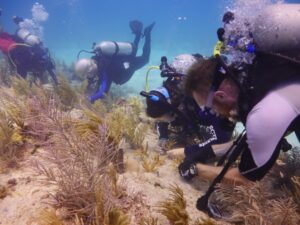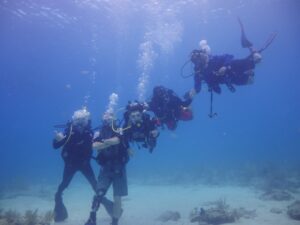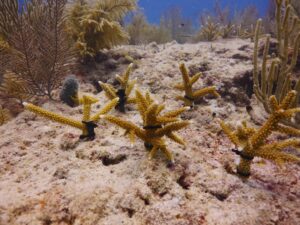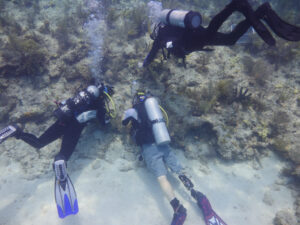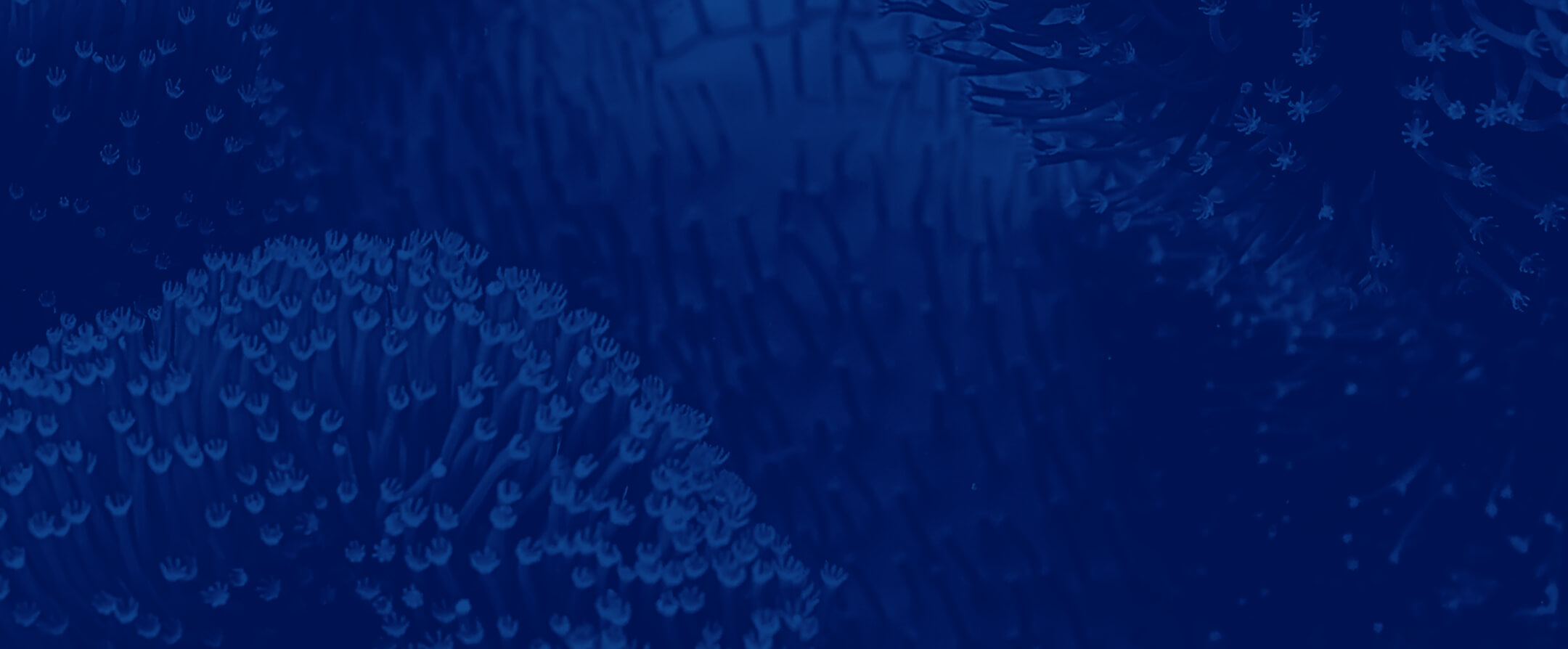Over the past two weeks, several groups have conducted a Mote Marine Laboratory partnership mission to restore coral.
Working with Mote scientists, members of SCUBAnauts International, Combat Wounded Veteran Challenge and Gold Star Teen Adventures helped plant threatened staghorn corals in a special restoration site near the Looe Key Existing Management Area (EMA) over the last two weeks. By the end of the day Tuesday, July 29, the groups planted 850 coral fragments and helped to create another 2,300 fragments that will be grown in Mote’s underwater coral nursery and then planted on the reef in the future.
The event also marked the creation of a new restoration area to honor the sacrifices of American servicemen and women set aside on a patch reef about a mile long east of the Looe Key EMA .
“Our mission with this project is multi-faceted,” said Dr. Michael P. Crosby, President & CEO of Mote Marine Laboratory. “Because we have the southernmost marine research laboratory in the nation, we’re ideally situated with both location and technical expertise to launch major initiatives to restore the only barrier reef in the continental U.S. Expanding our unique Mote-Combat Wounded Veteran Challenge-Gold Star Teens-SCUBAnauts ‘citizen scientists’ partnership also exemplifies our dedication to helping the public understand ocean ecosystems and in supporting the next generation of scientists. But the most rewarding aspect of this project goes even further by offering us at Mote an opportunity to thank our veterans and their families for the sacrifices they have made.”
Sacrifices like those made by Master Sgt. James “Trey” W. Ponder III, who was one of 16 killed conducting combat operations in the Kumar Province in Afghanistan in 2005. The movie “Lone Survivor” was based on the incident surrounding his death and that of his fellow soldiers.
His wife Leslie and children Elizabeth, 15, and Samantha, 16, joined in the restoration trip as participants in Gold Star Teen Adventures, which provides adventure camps to children who have lost a parent in the line of duty.
“This is our first experience of merging Gold Star teens with Combat Wounded Vets,” Leslie Ponder said. “But they automatically connected… people who aren’t in the military mean well, but they don’t always know what to say. Here, we didn’t have that awkwardness. It was the best today when I turned around on the boat and they were all talking and laughing. It was great.”
More than seven years ago, Mote established an underwater coral nursery where scientists grow colonies of the threatened staghorn coral (Acropora cervicornis) for replanting on decimated or damaged sections of reef within the Florida Keys National Marine Sanctuary. When the colonies reach a suitable size, small fragments nearly 2 inches long (about 5 cm) are snipped off and used to create a new colony — similar to the way new plants are grown from cuttings of existing plants.
The work done by the volunteers in the nursery over the past two weeks included making new coral fragments from existing colonies and also planting fragments on a patch of reef.
“It’s been particularly rewarding for us because we get to see the SCUBAnauts in action and we get to see first hand how Mote is working to restore reefs along the coast,” said 32-year-old Billy Costello, retired Sgt. 1st Class, U.S. Army, who lost his right leg above the knee after stepping on a landmine in Afghanistan in 2011.
This is the third year that Costello has volunteered in Mote’s coral nursery as a member of the Combat Wounded Veteran Challenge. “To be part of that big project is pretty rewarding,” he said.
While as a member of SCUBAnauts International Mia Foisy, 14, of Dunedin, Fla., gets pretty excited about restoring coral reefs, she’s also pretty impressed by the veterans she’s met over the last few years she’s participated in this project. “I like to work with the vets because it reminds me that no matter what, you can keep going. It doesn’t matter what happens, you can always take the next step. Whether you lose a limb or get a concussion, you’re always able to move forward.”
Thanks to work by Mote scientists and these volunteer groups, there are a quarter of a million coral fragments available to restore Florida’s reef.
“This is really an example of Mote’s philosophical approach: partnering with the community, bringing in citizen scientists so that everyone can be engaged together in restoring our shared resource — these valuable coral reefs right here in the Florida Keys. This is a wonderful day and a wonderful program.”
About
- Gold Star Teen Adventures provides adventure camps to the surviving youth of Army, Navy, Air Force and Marine Corps Special Operations personnel who have lost their lives in the line of duty.
- The Combat Wounded Veteran Challenge improves the lives of wounded and injured veterans through rehabilitative high-adventure and therapeutic outdoor challenges while furthering the physiological, biomedical and pathological sciences associated with their injuries.
- SCUBAnauts International’s mission is to guide young men and women ages 12 through 18 along an exciting pathway for personal development by involving them in the marine sciences through underwater marine research activities, such as special environmental and undersea conservation projects, that build character, promote active citizenship and develop effective leadership skills.
